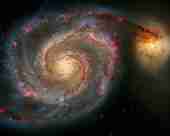 | > Other English exercises on the same topic: Nature [Change theme] |
| > Similar tests: - In the sea - Animals and pictures - Fruit-trees - In the garden-vocabulary - Flowers - Vocabulary, The sun: a friend or an enemy - Vocabulary: Sea animals - Vocabulary: Gardens and gardening... | |
| > Double-click on words you don't understand |
Universe
GALAXIES
There are billions of galaxies in the Universe. A galaxy is a large collection of stars.
It also contains gas and dust. Many galaxies continue to form new generations of stars.
 There are three kinds of galaxies: spiral, elliptical
There are three kinds of galaxies: spiral, elliptical
and irregular (which doesn't really have a shape)
Spiral galaxies look like giant pinwheels in the sky.
Our Solar System is located in the Milky Way Galaxy.
It 's a spiral galaxy like this one.  It has spiral arms and a bright central part.
It has spiral arms and a bright central part.
The ancient Greek astronomers thought that The Milky Way looked like a river of milk running through the sky.
Galaxy comes from the Greek word for milk.
English exercise "Universe" created by lili73 with The test builder. [More lessons & exercises from lili73]
Click here to see the current stats of this English test
End of the free exercise to learn English: Universe
A free English exercise to learn English.
Other English exercises on the same topic : Nature | All our lessons and exercises


 There are three kinds of galaxies: spiral, elliptical
There are three kinds of galaxies: spiral, elliptical  It has spiral arms and a bright central part.
It has spiral arms and a bright central part.